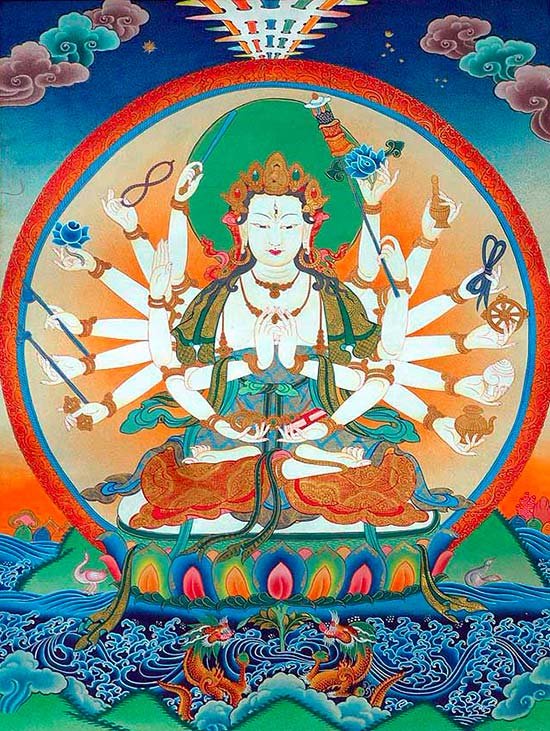Maha Prajnaparamita Sastra
by Gelongma Karma Migme Chödrön | 2001 | 941,039 words
This page describes “vishvantara-jataka (or vessantara-jataka)” as written by Nagarjuna in his Maha-prajnaparamita-sastra (lit. “the treatise on the great virtue of wisdom”) in the 2nd century. This book, written in five volumes, represents an encyclopedia on Buddhism as well as a commentary on the Pancavimsatisahasrika Prajnaparamita.
Part 6 - Viśvantara-Jātaka (or Vessantara-jātaka)
Thus the prince (kumāra) Siu t’i na (Sudinna?), in the language of Ts’in “Excellent Generosity”, gave his two children (putra) to a brahmin, and then he gave his wife, without his heart being upset by emotion.
Notes on the Viśvantara-jātaka:
The Mppś will return to this jātaka later (k. 33, p. 304c):
“The bodhisattva Siu ti nien na (Sudhinna) gave a fine white elephant to an enemy family; withdrawn into the depths of the mountains, he gave twelve ugly brahmins his two dear sons; then he gave his wife and his eyes to a fictive brahmin. Then the earth shook violently, the heavens rolled with thunder and the ether rained down a rain of flowers.”
We are dealing with a quite special recension of the well-known Viśvantarajātaka. Whereas Viśvantara is elsewhere called Sudāna “Excellent generosity” (T 152, k. 2, p. 7c29; T 171, p. 418c16), Sudanta or Sudāṃṣṭra “With Beautiful Teeth” (T 2087, k. 2, p. 881b8; Rāṣṭrapālaparipṛcchā, p. 22., l. 18; Lalitavistara, p. 167, l. 21), here he is surnamed Sudinna “Excellent Generosity”. In the other sources, it is to a single brahmin that he gives his children and not to, as here, “twelve ugly brahmins”. Finally, the mention of the gift of the eyes, after that of the wife, occurs only here.
The story is well known:
“Viśvantara, or Vessantara, was a young prince who had a passion for generosity. He had a white elephant endowed with the magical power of bringing the rains. A neighboring king whose land was afflicted with aridity, asked for the animal. Viśvantara gave it to him; his countrymen were furious and demanded his punishment. The generous prince had to leave in exile, accompanied by his wife Madrī who wanted to share his exile and their two children, Jālin and Kṛṣṇājinā. On the way, two brahmins demanded the horses of his chariot: he gave them away; a third demanded the chariot itself: he gave it. At the cost of a thousand sufferings, the exiled family finally arrived at the forest of Vaṅka chosen for his exile. They lived there in a hut, eating roots and wild fruits. The trees, moved by compassion, bent down their branches to offer their fruit to the two children of Viśvantara and Madrī. But a new brahmin named Jūjaka arose and demanded that the father give him the two children to be his servants. Despite their terror, despite the desolation, he gave them. The god Indra, disguised as an ascetic, came and demanded his wife as slave: he gave her also. Finally Indra made himself known and gave back to the hero his family and his goods.” (R. Grousset).
Here is a summary of the main sources:
Pāli sources: Jātaka no. 547, VI, p. 479–596; Cariyāpiṭaka, I, no. 9, p. 78–81 (tr. Law, p. 100–105). – Many allusions or references: Jātaka. I, p. 47; Milinda, p. 112, 274; Samantapāsādikā, I, p. 245; Dhammpadaṭṭha, I, p. 69; Vibhaṅga Comm., p. 414; Mahāvaṃsa, XXX, v. 88; Còlavaṃsa, XLII, v. 5. Avadānakalpalatā, no. 23, vol. I, p. 646–551. Allusions in Rāṣṭrapālaparipṛcchā, p. 22, l. 18; Lalitavistara, p. 167, l. 21.
Tibetan sources: Dulwa, tr. Schiefner-Ralston, Tibetan Tales, no. 16, p. 257–272; J. Bacot, Drimedkundan, Une version Tibétaine dialoguée du Vessantara Jātaka, JA, 1914, p. 221–305.
Chinese sources: Lieou tou tsi king, T 152, no. 14, k. 2, p. 7c–11a; T’ai tseu siu ta na king, T 171, p. 418c–424a (tr. Chavannes, Contes, III, p. 362, 395; Ken pen chou… yao che, T 1448, k. 14, p. 64c–69a; Ken pen chouo… p’o seng che, T 1450, k. 16, p. 181a–184b; King liu yi sinag T 2121, k. 31, p. 164c–166c. – The Chinese pilgrims described at length the places sanctified by Viśvantara’s sacrifice: Song Yun, Lo yang k’ie lan ki, (tr. Chavannes, BEFEO, III, 1903, p. 413–414; 419–420); Hiuan tsang, Si yi ki, T 2087, k. 2, p 881b (tr. Beal, I, p. 111–113; Watters, I, p. 217–218;): they locate, respectively, the legend at Fo cho fou and at Po lou cha, which Foucher locates at Shāhbāz-garhī.
Sogdian sources: É. Benveniste, Vessantara Jātaka, Texte sogdien, 1946.
In Cambodia: A. Leclerc, Le livre de Vésandar, le roi charitable, d’après la lecon camboddgienne, L. Finot, BEFEO, III, 1903, p. 320–334.
In Laos: S. Karpèles, Chronique de l’École Francaise d’ExtrĪme-Orient, Laos, BEFEO, 1931, p. 331 (local holiday at Vieng Chan in honor of the reading of the Vessantarajātaka).
Iconography: for Bhārhut, see Mémoires concernant l’Asie orientale, III, pl. 2,1); Barua, Barhut, III, pl. 91; JRAS, 1928, p. 390–398. – Marchall-Foucher, Mon. of Sanchi, I, p. 225–226; II, pl. 23a 1, 25 (1), 29 (3), 31 (1). – Foucher, Art Gréco-bouddhique, I, p. 284, fig, 144; AR Arch. Surv., 1907–1910, pl. 17 (a, c). – Sīvaramamurti, Amarāvartī, p. 260–262; pl. 63(5). – Ramachandran, Sculptures from Goli, p. 7–12, pl. IV-VI; – Ajaṇṭā, cave XVII.
